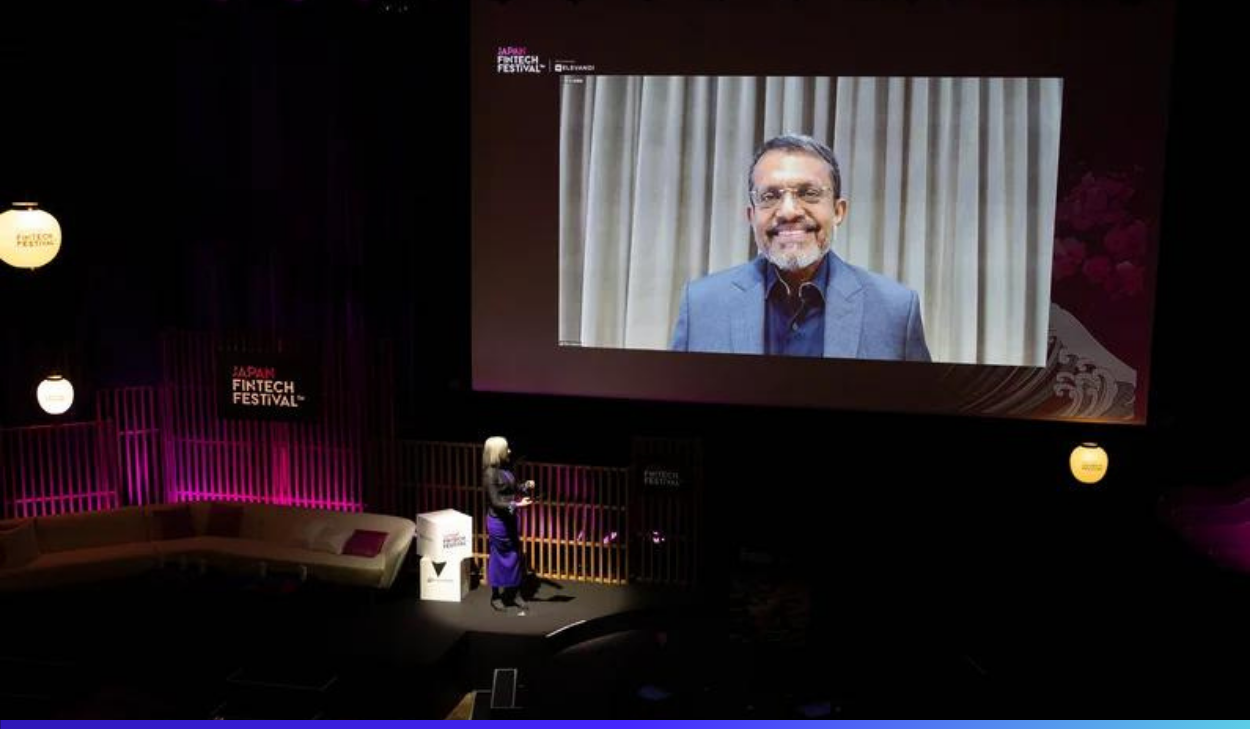Four Trends in Global Fintech
Opening Address at Japan FinTech Festival
Kanda Myojin Shrine, Tokyo, via teleconference from Singapore
4 March 2024
Good morning and welcome to the Japan FinTech Festival 2024.
Japan has a long tradition of being a technological powerhouse.
- In the half-century since 1945, Japan rose from the ashes of war to become a global leader in the application of technology, with a deep commitment to innovation and excellence.
- Those of us who grew up in that period will recall Japan’s technological prowess across diverse industries like automobiles, consumer electronics, and robotics.
- Japan continues to thrive in these areas but in the last three decades, it has not been quite at the forefront in digital devices and solutions.
- Particularly in the area of financial technology, or FinTech, Japan has not fully realised its potential.
Prime Minister Fumio Kishida’s vision of a New Capitalism offers a significant opportunity to kick-start and turbo-charge Japan’s FinTech sector.
- It lays out a strategy to reform Japan’s financial and capital markets and unleash a virtuous cycle in investment to transform Japan’s economy.
- There is a 400 billion Yen commitment to upskilling the workforce.
- There are plans to scale up investments in critical areas like semiconductors, as well as in key emerging areas like quantum technology, artificial intelligence, and biotechnology, including attracting investments worth 150 trillion Yen in green economy initiatives such as hydrogen and renewable energy over 10 years.
- There is a five-year plan to bolster the startup ecosystem, including reforms to
increase venture capital funding for innovative startups. The goal is to support the creation of 100,000 startups and 100 unicorns in Japan by 2027. - In short, there is great opportunity in Japan for entrepreneurs, startups, and
established financial institutions to collaborate and drive FinTech innovation.
The FinTech world that Japan will seek to play a key role in has seen dramatic changes over the last 10 years. Let me highlight four key trends in global FinTech that I believe have the potential to transform the global economy and financial system.
The four big trends are:
- One, the proliferation of cheaper and faster electronic payments from domestic to cross-border applications;
- Two, the use of distributed ledgers and tokenisation to potentially create a more efficient financial architecture;
- Three, the application of Artificial Intelligence, especially generative AI, in financial services; and
- Four, the growing potential of quantum technologies.
Electronic Payments
Let me start with electronic payments.
- The global FinTech phenomenon began about 10 years ago, driven primarily by inovation in digital payments.
- Non-bank players began to offer innovative payment solutions that were cheaper and faster, based on digital wallets and integration with e-commerce platforms.
The first phase of payments innovation saw the emergence of national digital payment systems, enabling 24/7 real-time money transfers at zero cost.
- These were public payment rails that offered an open, interoperable infrastructure, enabling both banks and non-banks to provide innovative payment services to consumers
- Examples include the UK’s Faster Payment System in 2008, India’s Unified Payments Interface in 2016, Singapore’s PayNow in 2017, and Brazil’s Pix in 2020.
- These interoperable payment rails allowed innovation to flourish while ensuring
safety and security. While non-banks drove innovation in the front-end user
experience, back-end settlements remained securely rooted in the trusted framework of regulated banks. - Today, there are around 60 digital payment systems worldwide, with two-thirds of adults able to make or receive digital payments. They have enhanced financial inclusion and business efficiency
The second phase saw the establishment of bilateral linkages between national digital payment systems.
- It began with the integration of Singapore’s PayNow with Thailand’s PromptPay, and subsequently with India’s UPI and Malaysia’s DuitNow. These linkages have helped migrant workers send money back to their homes at much lower cost and greater speed.
- We are also seeing a flurry of bilateral QR payment linkages - example: Thailand-Cambodia; Indonesia-Malaysia; Cambodia-Vietnam. These linkages allow tourists from these countries to make payments at merchant points in the other linked
countries. - But setting up bilateral payment linkages is time-consuming and resource-intensive.
We are thus moving into the third phase - building multilateral real-time payments connectivity
- Project Nexus, a collaborative initiative by The Bank for International Settlements Innovation Hub at its Singapore Centre aims to create a multilateral network
connecting domestic instant payment systems across different countries - It is an initiative, initially among the five ASEAN nations of Singapore, Indonesia,
Philippines, Malaysia and Thailand. - Following a successful prototype connecting the faster payment systems of the
Eurozone, Malaysia, and Singapore, Project Nexus is now on the implementation path to achieve multilateral payment connectivity across the five ASEAN countries
Cross-border payment connectivity is also being achieved outside traditional public rails.
- For example, we have private-sector innovations like Onafriq, a pan-African payments system that seamlessly connects 500 million mobile wallets across 40 countries.
- Onafriq’s integrated network of mobile network operators, money transfer operators, and banks has simplified payments and transactions across the continent.
What is striking about the evolution of electronics payments over the last 10 years is how so much of it has been pioneered in the Global South, and especially in Asia, and how so much of it has been driven by the imperative of financial inclusion. It hastruly been innovation with purpose.
Distributed Ledgers and Tokenisation
The second trend: the use of distributed ledgers and tokenisation in a quest to create a more efficient global financial architecture. This new ecosystem comprises three key components: digital assets; digital money; and digital infrastructure.
First, digital assets. The key innovation behind digital assets is tokenisation, namely the use of software programmes to represent as a digital token the ownership rights over any item of value
- Tokenisation is potentially as big, if not bigger, an innovation as securitisation.
- It allows high value financial and real economy assets to be fractionalised and
exchanged over interoperable platforms, like the Internet, on a peer-to-peer basis without intermediaries. - It also allows atomic settlement or the simultaneous exchange of two assets in real time.
An obvious and early application of tokenisation has been in financial assets. Digital financial assets are proliferating rapidly
JP Morgan’s Tokenized Collateral Network uses distributed ledger technology to
convert money market shares into digital tokens, which then serve as collaterals for over-the-counter derivative deals.
Policy and regulatory impetus to facilitating digital assets is gaining traction.
- The Monetary Authority of Singapore, along with partners from the financial industry, has launched an initiative called Project Guardian to lay down frameworks and protocols to harness the benefits of tokenised assets.
- Project Guardian aims to integrate digital assets seamlessly into mainstream financial operations, like listing, distribution, trading, settlement and asset servicing.
- In its first pilot, DBS Bank, JP Morgan and SBI Digital Asset Holdings conducted
transactions in tokenised foreign exchange and government bonds, including
tokenised Japanese Yen and tokenised Japanese government bonds. Subsequent pilots have sought to tokenise trade finance and wealth management products.
Japan’s Financial Services Agency (FSA) is a part of Project Guardian’s Policy Maker Group established in 2023, along with Switzerland, Singapore, the United Kingdom and the IMF.
Second, digital money. It enables the payment, clearing, and settlement of digital or tokenised assets simultaneously on the same platform. But like all other money, digital money must have stability of value and security of redemption.
There are four contenders for digital money.
- Privately issued cryptocurrencies
- Central bank digital currencies or CBDCs
- Tokenised bank liabilities
- Well-regulated stablecoins
Private cryptocurrencies have failed the test of digital money. They have performed poorly as a medium of exchange or store of value beyond that for purposes of speculation.
CBDCs, tokenised bank liabilities, and well-regulated stablecoins are much more promising as digital money.
- SWIFT has launched the testing phase of a CBDC interoperability connector that links the CBDCs of 3 central banks — the Hong Kong Monetary Authority, the National Bank of Kazakhstan and the Reserve Bank of Australia — and 30 financial institutions. The objective is to create conditions for the seamless coexistence of new digital currencies with existing fiat-based currencies and payment systems
- Citibank is piloting Citi Token Services for cash management and trade finance for its institutional clients. The trials will integrate tokenised deposits and smart contracts into Citi’s global network, enabling their clients to transfer liquidity between Citi branches on a 24/7 basis.
- Amazon and Grab, partnering with Singaporean fintech StraitsX, the issuer of XSGD (a Singapore dollar stablecoin), have piloted a novel system leveraging "purpose-bound money." This technology utilizes a secure digital wrapper to enhance security and trust in online transactions. Functioning similarly to an escrow service, it guarantees that buyers receive their purchases before sellers obtain payment.
The third component of the new financial architecture is: digital infrastructure. Existing digital asset networks - in the form of either public permissionless blockchains or private permissioned blockchains - are not fit-for-purpose as a global infrastructure for digital assets.
We need open and interoperable digital networks that are compliant with regulatory
requirements.
- In Japan, the corporate sector has taken the lead in developing a blockchain-based consortium of more than 100 members, including Japan’s three big banks – Mitsubishi UFJ Financial Group, Sumitomo Mitsui Banking Corp. and Mizuho Financial Group, the telecom group NTT and transport group East Japan Railway.
- Internationally, the Monetary Authority of Singapore, in collaboration with industry partners like BNY Mellon, DBS Bank, JP Morgan and MUFG, has initiated a project to serve as a global public good digital infrastructure, through which cross-border transactions and trading of a range of tokenised assets can be done seamlessly.
Together, digital assets, digital money, and a foundational digital infrastructure have the potential to realise the vision of seamless financial transactions across the world.
Artificial Intelligence
The third big trend in FinTech that will be of growing importance and impact in the years ahead is Artificial Intelligence.
AI, often misconstrued as a single technology, encompasses a diverse range of technological models aimed at replicating human intelligence in various tasks. They are already having applications in FinTech
- Machine Learning Models or MLMs identify patterns in datasets using computational power and advanced algorithms
Example: Singapore's DBS Bank's financial planning tool, the NAV Planner,
leverages MLMs to recommend suitable investment products and offer
personalised financial advice based on individual customer profiles.
- Deep Learning Models or DLMs analyse multiple layers of complex data to train
sophisticated artificial neural networks.
DLMs empower banks to predict customer churn with higher accuracy by
analysing vast amounts of transaction history, demographics, product usage,
and customer interactions. This allows banks to focus their retention efforts
more effectively.
- Large Language Models or LLMs process massive amounts of text data to predict human language patterns and create content.
Example: Bank of America's Erica, an LLM-powered chatbot with over 10
million users, has handled over 100 million client requests, assisting with tasks
like balance checks, payments, and credit reports.
- Generative AI or Gen AI uses various AI technologies to create new content, including text, images, music, and more. Large language models (LLMs) are a specific tool within this toolbox, designed for generating and processing text in a human-like way.
Example: Japan's Fujitsu, Hokuriku Bank, and Hokkaido Bank have announced
joint trials to explore Gen AI for banking operations. They will leverage Fujitsu’s
AI platform to automate tasks like responding to internal inquiries, generating
and checking documents, and creating software programmes.
But to safely harness the tremendous potential of AI for the financial sector, we need to address its significant challenges. Let me highlight three of them:
- First, bias and factual errors. AI models trained on incomplete or biased data can generate seemingly plausible but factually incorrect predictions or content. This can lead to flawed financial decisions regarding credit, investments, or other areas.
- Second, data privacy concerns. AI's reliance on extensive data raises concerns about customer privacy. Even discarded data can be used to draw unintended inferences, and AI can be misused to facilitate sophisticated scams and phishing attempts by mimicking real human behavior.
- Third, workforce skills gaps. The rapid evolution of AI technology creates a widening gap in industry readiness. Our workforces often lack the necessary skills to navigate an AI-driven financial landscape, and upskilling efforts might struggle to keep pace.
Major jurisdictions are establishing principles and guidelines to mitigate the potential downsides of deploying AI in various sectors.
- The European Union's proposed Artificial Intelligence Act aims to establish
harmonised rules while fostering innovation and mitigating risks, especially in high-impact sectors like climate change, healthcare, and finance. It establishes obligations for AI based on its potential risks and level of impact. - Japan's Social Principles of Human-Centric AI set out the framework for responsible AI development. These principles encompass human-centricity, education, privacy, security, fair competition, fairness, accountability and transparency, and innovation.
- Singapore has developed AI Verify, an AI governance testing framework and software toolkit that utilises 11 AI ethics principles aligned with international frameworks.

Quantum Technology
The fourth big trend in FinTech is more nascent: applications of quantum technology
- Leveraging the principles of quantum mechanics, this technology promises to revolutionise various fields through its radically new approaches.
- Investments in quantum innovation are projected to rise from US$80 million in 2022 to US$19 billion by 2032.
Quantum technology has strong potential applications in financial services.
- FinTech firms are working on solutions to complex problems like portfolio
optimisation, derivatives pricing, risk modeling, and fraud detection, using the
potential of quantum computing
But quantum computing also poses substantial - and perhaps existential - cybersecurity risks.
- The integrity of financial infrastructure, communications, and data is at stake.
Encryption protocols could be compromised, potentially undermining the
fundamental pillars of finance – trust and stability. - The "harvest now, decrypt later" approach taken by cyber criminals today highlights the urgency to address these vulnerabilities before they become exploitable by future quantum computers.
Embracing quantum technology safely requires a collaborative leap in preparedness. Our ability to adapt and innovate in cryptography will be crucial for harnessing the potential of quantum technology without succumbing to its security risks.
- Japan's Q-STAR initiative identifies global use cases in quantum technology, sets out industry roadmaps for a quantum-powered future, and aims to extend the benefits of quantum technology to 10 million people by 2030.
- Singapore and Japan are collaborating on the NQSN+ Digital Connectivity
Blueprint. This is Southeast Asia’s first quantum-safe network infrastructure that aims to standardise Quantum Key Distribution protocol by enabling two parties to produce a shared random secret key for secure encrypted communication.
Conclusion
The global FinTech wave that began some ten years ago continues to ascend.
- While the electronic payments revolution is in its heyday, we are still in early
days in tokenisation, AI, and quantum computing. - There is potentially much exciting innovation ahead, not to mention economic
benefit and social good.
But before I close, I want to highlight a fifth area where FinTech needs to do more - this is in the area of sustainability.
- The scorching heat of 2023 - which affected Japan too - serves as a stark
reminder that climate change is real, that time is running out, and that global
collaboration towards sustainability is urgent. - A critical area of gap that FinTech can potentially help to fill is in climate-related
data and disclosure. There are some early efforts.
Example: the Greenprint integrated platform, developed by Grpnt.ai and
supported by the Monetary Authority of Singapore, alongside HSBC,
KPMG, MUFG, and Microsoft, aims to provide a simplified disclosure
reporting tool, customised transition path insights, and a marketplace
for sustainability-focused services, to help businesses and financial
institutions navigate their sustainability journeys.- But we need much more progress on this front.
Platforms like the Singapore and Japan FinTech Festivals play a vital role in fostering cross-border collaboration for 'FinTech for Good.'
- Together, we can navigate the challenges and harness the opportunities of global FinTech, and build a more inclusive and sustainable future.



COMMENTS